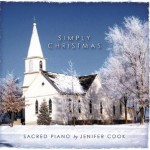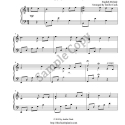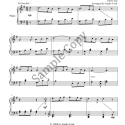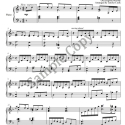December 22nd, 2012
The wide note range of O Holy Night makes for a challenging vocal solo!
B Flat Major seems to be a comfortable; reasonable key when singing “O Holy Night”. Therefore, I will provide a FREE copy of O Holy Night in this key.
Keep in mind…I’ve already shared this arrangement on my free Christmas music page in the key of A flat major. I simply transposed the same arrangement to B flat major. The key of B flat major works great for a male solo or duet. Sopranos like this key too because the high notes are easier to reach.
See video below of a male vocal duet I recently played for…using the key of B flat major for O Holy Night. Special note: I used a different arrangement 🙂
**Click on link below video to get your FREE copy of O Holy Night in the key of B Flat Major.
Tags: o holy night, o holy night in b flat major
Posted in christmas, Free music, Seasonal / Other, Special Music, transposing hymns, Videos, Vocal | 22 Comments »
December 21st, 2012
And….the winner is…
Congratulations to Carolyn who won the drawing for a free copy of my Simply Christmas CD.
Posted in Uncategorized | No Comments »
December 16th, 2012
I just published an early advanced Christmas piano solo of “The First Noel” in the key of C Major. This arrangement, containing two verses, would be easy to learn for the average church pianist.
Early advanced Christmas piano solo, 4 pgs. Approx. 1:57 min.
Price: $3.50
Tags: advanced christmas piano solo, church pianist, the first noel
Posted in christmas, Music Store, Offertories, Seasonal / Other | No Comments »
December 15th, 2012

I plan to post a new advanced Christmas piano solo arrangement of “The First Noel” tomorrow. This particular arrangement is also on my “Simply Christmas” Cd. *The bell instrumentation will not be included in this arrangement.
Most of my arrangements on this CD were spontaneous… by ear. It has been a challenge for me to put these songs into written form. When I play by ear…I don’t always play correct/balanced harmony…so I”m forever grading/correcting myself as I see on paper what I really played. (ouch!)
“The First Noel” has such a soothing melody. I enjoyed putting this one down in writing 🙂
Tags: advanced christmas piano solo, the first noel
Posted in christmas, Music Store, Seasonal / Other | No Comments »
December 14th, 2012

Today is your last chance to leave a comment to enter the drawing for a FREE Christmas CD…
Just thought I’d give my readers an opportunity to win a copy of my Christmas CD entitled: “Simply Christmas”.
Click here for audio samples
Rules for Giveaway of Simply Christmas CD
1. Leave a comment at bottom of this article to enter your name one time.
2. Share the link to this giveaway on your personal blog, facebook or twitter and leave a second comment saying you did so.
This allows you to enter your name a second time in same drawing. (use my social share buttons at bottom of article for your convenience).
3. Drawing will be held on December 20, 2012 by 8pm EST
4. The winner will be notified by email the day of the drawing.
Important Information:
US Residents: The Church Pianist will pay all shipping (media rate)
Residents outside the US: The Church Pianist will cover up to $5 in shipping (media rate). Any shipping above $5 must be paid by winner.
Tags: christmas cd giveaway, church pianist, simply christmas cd
Posted in christmas, Free music, Seasonal / Other | 21 Comments »
November 28th, 2012
I thoroughly enjoyed creating this advanced Christmas piano solo of “What Child is This”.
The style of this piece was greatly influenced by my exposure to Spanish classical music…especially in verse one…right hand broken arpeggios with left hand melody. Enrique Granados was my favorite Spanish classical composer.
To be honest…I had a difficult time trying to figure out HOW to communicate the correct rhythm for the run in measure #35. I know how it’s suppose to sound..but it’s another story trying to get that across to everyone else. The run (in print)… played back the right way in my music program (Finale).
Hopefully…the following video of “What Child is This”… SHOULD be helpful. I did include a few tips at the end of the video for the right hand run in measure #35.
Tags: advanced christmas piano solo, what child is this, youtube video
Posted in christmas, Offertories, Seasonal / Other, Videos | 7 Comments »
November 27th, 2012

Now that Thanksgiving is over…I will be working on the recording of my advanced piano solo of “What Child is This”….which will include tips for the long run on measure #35.
Hope you all had a wonderful Thanksgiving! I look forward to sharing this video with you soon.
Tags: advanced piano solo, what child is this
Posted in christmas, Seasonal / Other, Technique | No Comments »
November 17th, 2012

I just posted another new late elementary piano arrangement of “Gesu Bambino“. This Christmas piano solo was written for one of my very industrious late beginner students several years ago and I just discovered it in my pile of files 🙂
My student really enjoyed playing this piece because of the flowing texture.
Late elementary Christmas piano solo, 2 & 3\4 pgs. Approx. length: 1:17
Price: $3.00
Tags: christmas piano arrangement, christmas piano solo, gesu bambino, late elementary piano solo
Posted in christmas, Offertories, Seasonal / Other, Special Music | No Comments »
November 15th, 2012

Just to let my church pianist readers know I just published a new advanced Christmas piano solo of “What Child is This”. I thoroughly enjoyed writing this Christmas piece!
My keyboard of 76 keys is used to record the complete audios of my arrangements but this particular arrangement contains a fast arpeggio run that goes beyond the length of my keyboard.
So… a youtube video of this piano arrangement will be available sometime soon.
Advanced sacred Christmas piano arrangement, 3 pgs. Youtube link below:
Price: $3.50
Tags: advanced piano arrangment, christmas piano arrangement, what child is this
Posted in christmas, Offertories, Seasonal / Other, Special Music | 4 Comments »
November 9th, 2012

Here is a free easy choir arrangement of “O Little Town of Bethlehem”. This is an easy two-verse arrangement for young girls and ladies’ SA group.
The young girls sing the first two lines of each verse and the ladies (soprano and alto) join on the third line.
Not a lot of prep time involved in learning this easy selection….allowing the singers to focus on the message.
I wrote this arrangement to go with the easy Christmas Program found at the following link:
Tags: easy choir arrangement, free easy choir arrangement, O Little Town of Bethlehem
Posted in christmas, Seasonal / Other, Special Music, Vocal | 1 Comment »








